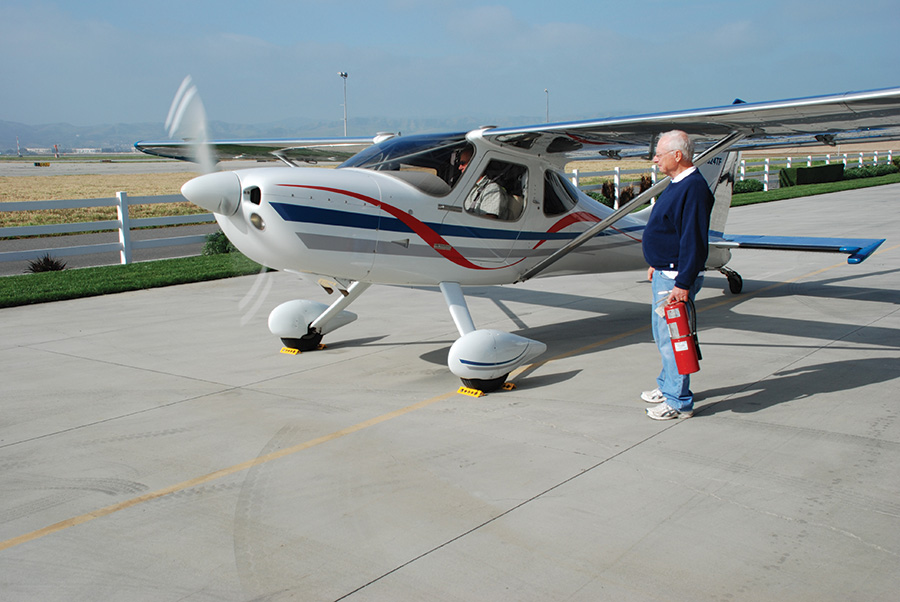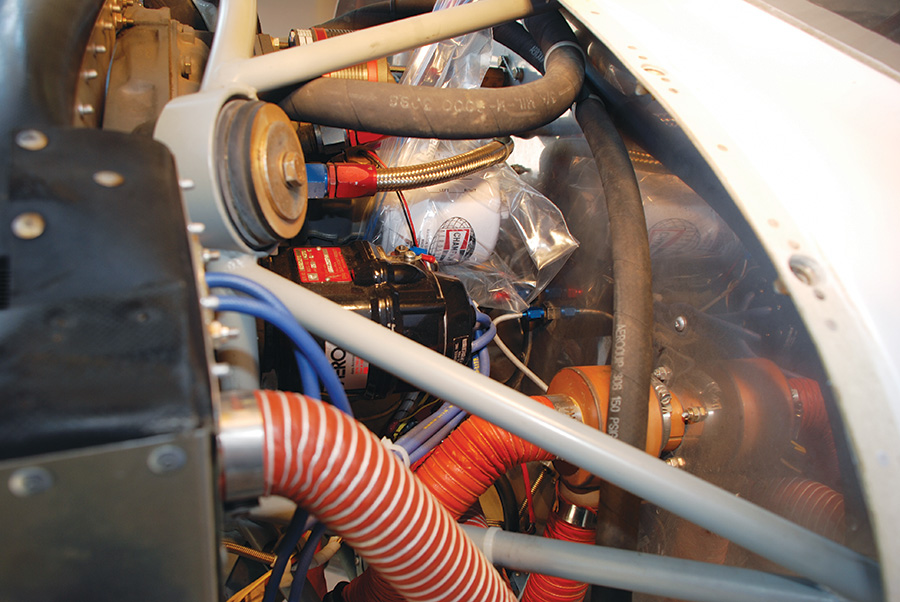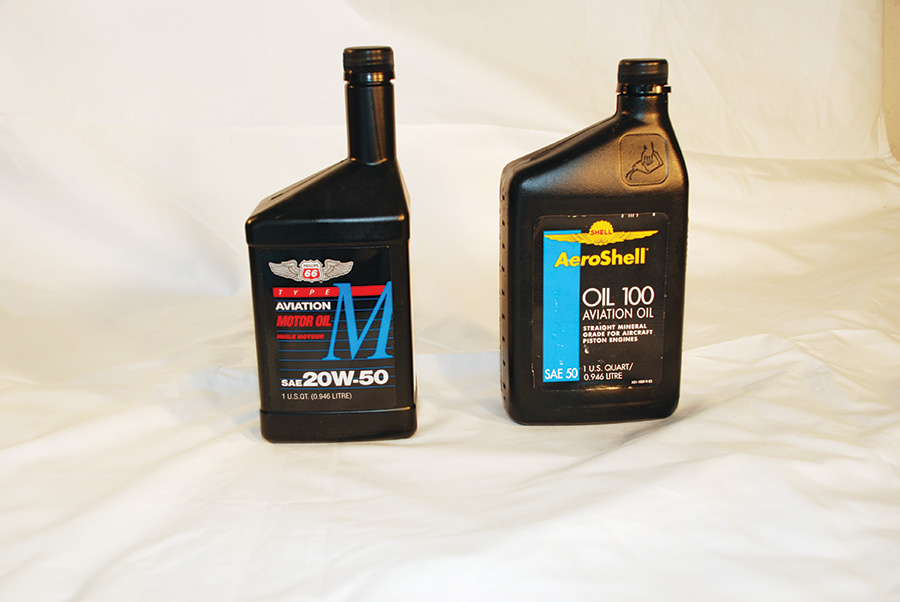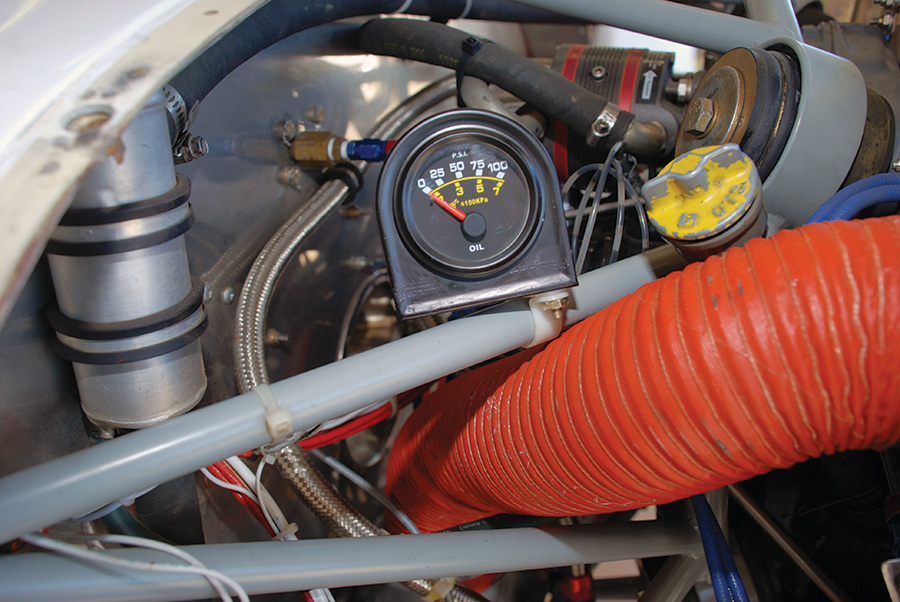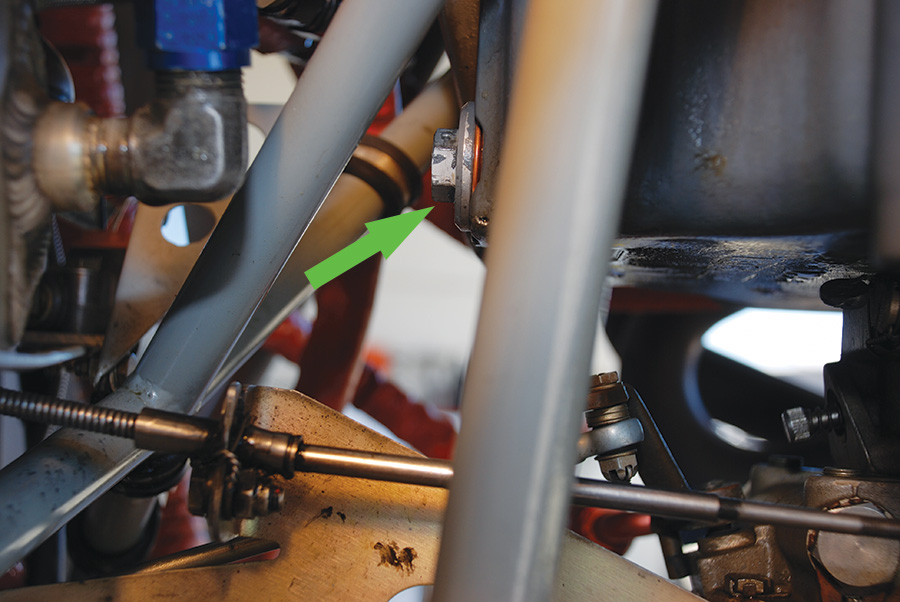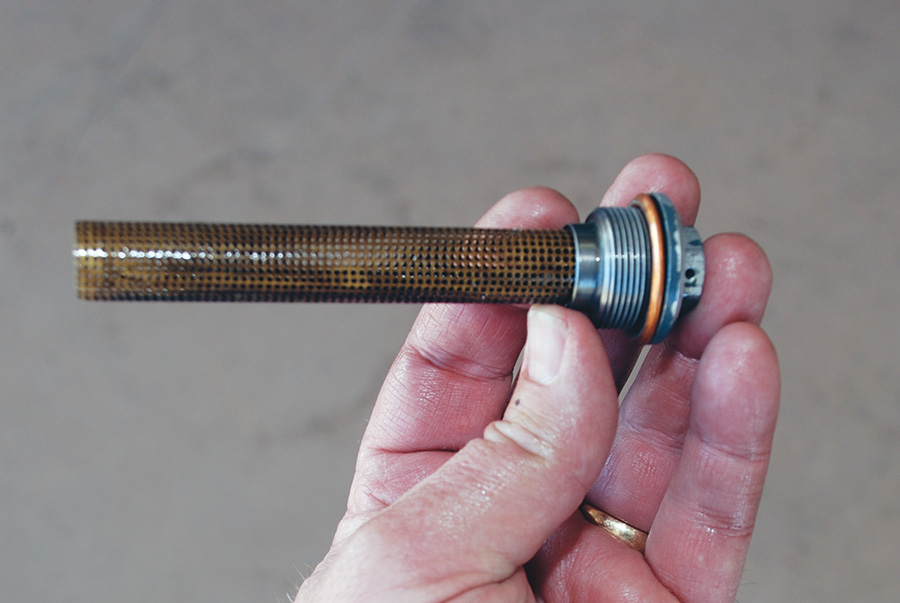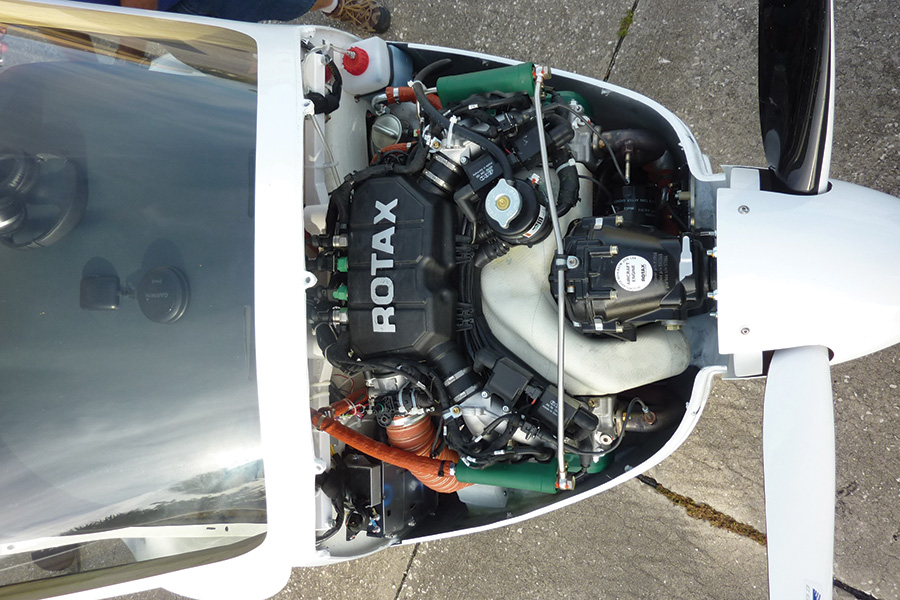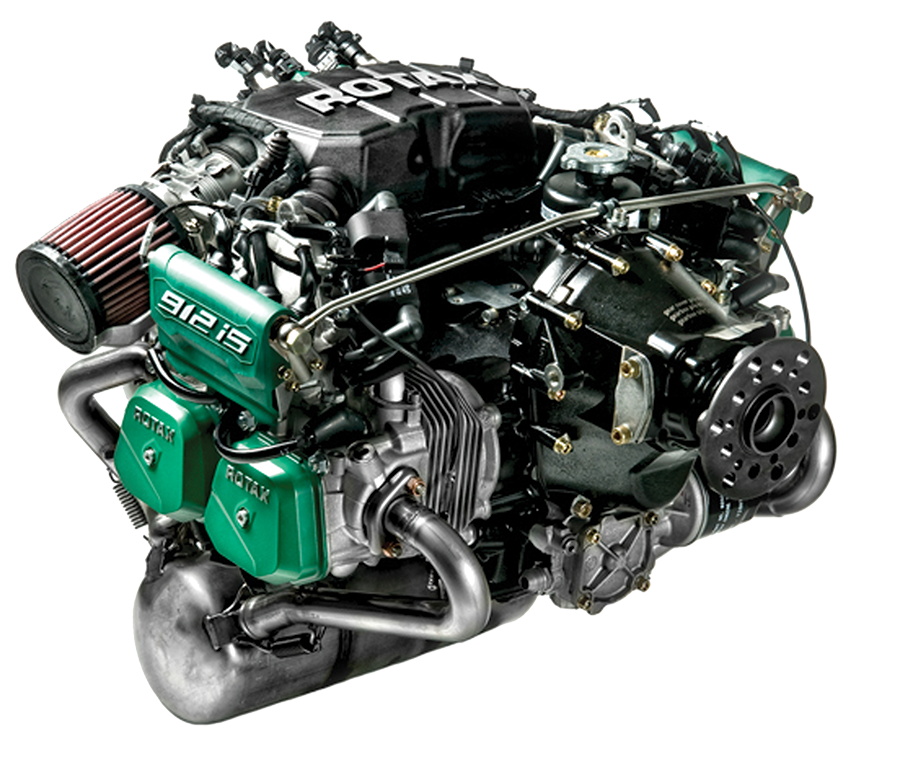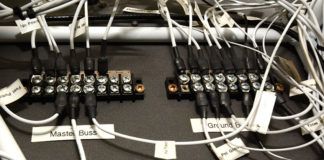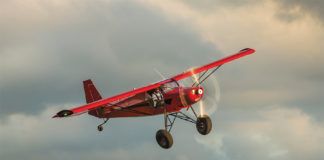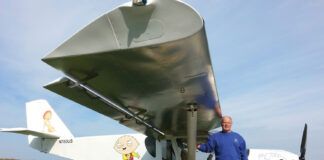Your airplane should be completely assembled for the first engine run. A friend with a fire extinguisher should be standing by.
The first time you start the engine on your airplane, you should be really close to completion. Not 90% done and 90% to-go close, but really, really close. This is because you will be removing the preservative measures that should have been in place all through the construction process, and you will now expose your engine to the corrosive elements of the atmosphere. You are now moving from not worrying about engine maintenance to being concerned about its regular use to maintain it in a relatively corrosion-free state. There is no point in doing this too soon. Ideally, your first engine start should occur no more than one month before your first flight.
Un-preserving the Engine
Your engine should have been preserved, either by the factory or your engine builder. If you got the engine as a factory-new engine from your kit manufacturer, it arrived at your door in a properly preserved state. In fact, no matter who you got it from, it should have been properly preserved. During construction certain parts were no doubt opened up to install the carburetor or fuel injection and the exhaust system, but after they were installed, they should have been sealed up again wherever possible. Now is the time to remove all of that.
Place a one-gallon plastic food storage bag over your oil filter before you remove it to catch oil that drips out once the filter is unscrewed.
The first step is to drain the preservative oil from the sump. Make sure your drain bucket can hold at least two gallons, so it won’t overflow. Recycle the drained oil at an approved disposal site, one of which can be found at most airports. Remove and replace the oil filter, too, since it will be filled with preservative oil. Now is a great time to install a quick drain in the oil sump. That will make future oil changes much easier and eliminate the risk of cross-threading the drain plug when you insert it back into its hole. All of the popular aircraft supply vendors sell quick-drain devices. And don’t forget to safety wire the quick drain and the filter after installing them.
Next remove all the desiccant plugs from the spark plug holes. Since there may be oil in the cylinders, be sure to have a drain pan in position to catch the dripping oil. With the plugs removed, turn the engine over a few times by hand to push out all the oil. Do not install new plugs yet.
Install a quick drain for your oil when you remove the preservative oil. You will save yourself a lot of mess and frustration with this one simple accessory.
Pre-oiling the Engine
Prior to starting a new or overhauled engine, or an engine that has been out of service for some time, it is important to make sure oil is flowing throughout the engine. This process is called pre-oiling and is addressed by Lycoming in Service Instruction No. 1241C, which is available on the Lycoming web site. Other engine manufacturers should have similar information available for you.
For Rotax engines, it is imperative that you follow the instructions in the Rotax Installation Manual (available online), because of the very different, dry-sump oil systems used in these engines. These engines do not use traditional aviation oil, and they require a different pre-oiling procedure. Although many of the first-start steps are the same as they are for a Lycoming engine, many are not. No attempt should be made to run a Rotax engine for the first time without a thorough review of the factory-recommended procedures.
With the preservative oil drained out and a new filter and quick-drain in place, put in the recommended amount of mineral oil. Do not use ashless dispersant oil for breaking in non-turbocharged Lycoming engines, except 76 series engines such as the O-320-H2AD or O-360-E series. Mineral oil is now available in straight 50W or 20W-50 multi-viscosity oil. AeroShell Grade 100 Mineral Oil is a straight SAE 50 oil, and is popular among aviators for engine break-in. Phillips makes Type M 20W-50 aviation oil that can be used for engine break-in if lower temperatures are expected during that time period. AeroShell also now has a multi-viscosity mineral oil available for break-in purposes. As a general rule, straight 50 weight oil is best used in temperatures of 60˚F or above, whereas 20W-50 is suitable for temperatures down to 0˚ F. Fill the oil cooler at this time and disconnect the oil cooler return hose where it connects to the engine near the top of the accessory case. Make sure the crankcase vent line is installed and clear of any obstructions.
Be sure that all tape, rags, temporary seals, and desiccants have been removed from the intake and exhaust systems. Make sure that everything firewall forward is secure, including such things as engine mounts, propeller bolts, wires, hoses, SCAT ducting and so on. Nothing should be loose or hanging. Verify that the mixture control will bring the carburetor or fuel injection to the full idle cut-off position. Make sure the full arc of the propeller and the surrounding area is clear of all people and other obstructions. With the airplane secure, the brakes set, the master switch on and the spark plugs out of the engine, turn the engine over with the starter until you see an indication of oil pressure. This should not take more than 10 to 15 seconds. Once you see steady oil pressure, stop cranking and let the starter cool off. After a brief cooling period you can crank the engine over for another 15 seconds to be sure you have steady oil pressure.
If you are unsure if your airplane’s oil pressure gauge is working, you can temporarily install a mechanical gauge, readily available from an auto parts store.
If pressure is intermittent, you may have air in an oil line somewhere. Disconnect the oil cooler return line and check for steady flow by cranking for not more than 15 seconds. Steady flow should appear quickly if there is sufficient oil in the engine. Avoid overheating the starter by excessive cranking. If there is no indication of oil pressure after a total of 60 seconds of cranking—in 10 to 15 second increments—stop turning the engine over and check these items:
• Make sure there is oil in the engine.
• Make sure all oil lines are secure and not leaking.
• Make sure you have connected the oil pressure sender to a suitable point on the engine where pressurized oil is available.
• Check the wiring to the oil pressure sender and the oil pressure gauge or engine management system.
• Make sure that the engine ground wire or strap is in place and secure. Note: Some engine sensors are sensitive to good grounding and may require a dedicated wire from the engine management system to the engine, especially if you are using the airframe for your ground conductor.
• Check to be sure that the parameters for the oil pressure sender you are using are properly programmed into the engine management system.
• Check to make sure there is no obstruction in the oil line from the engine to the remotely mounted oil pressure sender.
If all of these items check out, you must now determine whether the engine is not making oil pressure or the oil pressure gauge is just not reading properly. One way to do this is to get a mechanical oil pressure gauge from an auto parts store and connect it to the engine. Turn the engine over again as before and see what happens. If the gauge works, you have a sender or engine management system problem. Refer to the manufacturer’s literature for troubleshooting suggestions. If the mechanical gauge does not indicate oil pressure, you have an engine problem. That means you need to contact whoever sold you the engine and ask for help. If you put it together yourself, you are hopefully competent enough to also do your own troubleshooting. If not, get some professional help. If you are working with a used engine that you have not previously run, you may be about to get a nasty surprise, but hopefully not. Find a good mechanic and have him work with you to determine the problem with your engine.
In all likelihood, the pre-oiling process went well and you are ready to move to the next step. Check the engine oil level to be sure you still have sufficient oil, install the spark plugs, and prepare the airplane for its first engine start. Of course, spark plugs should be properly installed by using new gaskets, anti-seize compound on the threads, and torqued to the manufacturer’s recommended value—usually 35 foot-pounds for Lycoming engines.
One last point: Do not run the engine without the propeller in place. The engine needs to have a load on it to function properly, and damage to internal components can result if you run the engine without a prop. Besides that, there is nothing to secure the starter ring gear to the crankshaft if there is no prop installed.
Engine Start and Break-in
Proper break-in is vital to a long and trouble-free life of any engine. Considering the substantial investment you have in your engine, it is important to take your time and do things correctly. Lycoming covers this procedure in Service Instruction No. 1427C, which is available online. The main points of that publication are covered below, but consult this publication for the full description of the engine start and break-in procedure.
If you have a new or factory-overhauled Lycoming engine, your engine has already been run in a test cell prior to delivery to you. If your engine has been assembled, overhauled, or top overhauled by someone who does not have a test cell, then you will need to do the initial run-in. Here are the steps:
• Make sure the engine is completely assembled with all baffling and inter-cylinder baffles in place. This includes all engine-related parts necessary for flight such as the complete exhaust system, oil cooler, propeller (and governor, if applicable) and all engine controls. Do not run the engine without these parts in place.
• Make sure all engine sensors are properly installed and working. This includes program- ming the engine management system for the sensors used and setting up the various limits for each engine parameter being monitored.
• Pre-oil the engine as per Lycoming Service Instruction No. 1241C or other manufacturer’s recommendation.
• Install the engine cowling.
• Secure a fully-charged fire extinguisher for the engine test. It should be rated for gasoline fires.
• Locate the airplane outdoors in a safe and secure area, chock the wheels and turn it into the wind.
• Make sure the propeller area is clear, and start the engine. Look for oil pressure within 30 seconds. Stop the engine if oil pressure does not come up, and determine what is wrong before continuing.
• If a fire starts during the starting procedure, keep cranking the engine in an attempt to draw the fire into the engine. If fire continues, turn off the engine, shut off the fuel, and extinguish the flames with a fire extinguisher.
• If adequate oil pressure is noted, run the engine at 1000 RPM until the oil temperature stabilizes or reaches 140˚ F.
• Perform a magneto check or ignition system check as appropri- ate for your engine installation.
• Continue running the engine for 15 minutes at 1000 to 1200 rpm. Monitor engine temperatures and shut the engine down if necessary to keep temperatures within limits. If any malfunctions are noted, correct them before proceeding. Engine oil temperature should not exceed 210˚ F, and cylinder head temperatures should not exceed 420˚ F.
• Run the engine a second time for five minutes at 1500 rpm and cycle the propeller if applicable. Conclude this test by running the engine at full power for 10 seconds. Be sure the airplane and the surrounding area are secure before doing so.
• Check the engine for leaks, remove the oil sump screen and check it for debris. Remove and inspect the oil filter. If everything is clear, the engine is ready for flight testing.
After your first engine run, remove the sump screen to be sure there is no debris present. The safety wire has already been removed from this sump-screen plug. Be sure to replace the safety wire when you reinstall the plug.
First Flight Preparation
Your first flight should not be conducted until a number of important steps have been completed. It is not the intent of this article to present a comprehensive list of things involved in a first flight. That is best worked out with an EAA Flight Advisor and yourself, taking the particular features of your airplane and your airport into consideration. But here are some key points to consider:
• All FAA paperwork, including the issuance of an airworthiness certificate, must be complete before any flight testing. That includes so-called high-speed taxi testing, which does occasionally acciden- tally turn into a first flight.
• The entire airplane should be carefully inspected, including a thorough preflight inspection, prior to any flight.
• Make a plan for the first flight with the help of an EAA Flight Advisor. Due consideration must be given to emergency plans in case of an engine failure at any point in the first flight. Do not make the first flight yourself if you have any doubts about your ability to execute any part of the first flight plan.
• Be sure your first flight plans conform to the Phase I Flight Test restrictions listed in your Operating Limitations.
• Make sure your insurance coverage is in effect and that the proposed first flight pilot is named on the policy.
• Notify ATC and/or the airport manager, depending on your local airport situation, of your intention to conduct a first flight.
Be sure to check the engine compartment for leaks or other problems after the first engine run and after each test flight.
First Flight
From an engine perspective, these are the things you need to think about on that first flight:
• Start your engine and perform a thorough run-up.
• Do not apply takeoff power until oil temperature has reached 100˚ F.
• Take off at full power, closely monitoring oil pressure and temperature, cylinder head temperature, and fuel flow. Be prepared to execute your emer- gency plan if there are any problems.
• Climb at Vy to pattern altitude, then at cruise climb airspeed to flight test altitude, carefully monitoring temperatures.
• Reduce power to 75% power and conduct first flight tests as
per your plan.
• Return to airport and conduct a thorough inspection of the engine and related systems.
• On the second flight, cruise for one hour at 75% power and then for a second hour varying power between 65 and 75%.
• Finally fly at maximum power for 30 minutes if the airplane is performing within expected parameters.
• Avoid low manifold pressure at high RPM. Descend at low cruise power. Avoid rapid descents, especially at low power settings.
• Remove engine oil, oil sump screen, and oil filter to check for contaminants.
• Refill with mineral oil and resume flying at 65 to 75% power until break-in is complete.
• Change to ashless dispersant oil at 50 hours or when oil consumption stabilizes, whichever occurs first.
• After your first flight, be sure to log the date and any notable particulars in your engine and airframe logbooks.
The sump screen should be checked after your first test run and at least annually when you change oil after that.
Phase I Flight Test Period
Phase I testing is more than just flying off the time—it involves testing the aircraft’s stability and control, performance, and systems. From an engine perspective, here are the things you need to remember:
• Make a log of power settings and fuel flows at various speeds and altitudes. This information will be added to your Pilot Operating Handbook later.
• Note temperatures in various configurations and make adjustments to the engine cowling and baffles to produce the best possible results. Inspect the engine compartment frequently to detect any problems that may develop.
• Note any repairs or modifications made to your engine in the engine logbook.
• Note the successful completion of the Phase I Flight Test period in the airplane logbook.
These recommendations are targeted specifically at Lycoming engines, because that is the brand of engine most commonly found in Experimental/Amateur-Built airplanes. If you are using another brand of engine, be sure to familiarize yourself with the installation and operating recommendations of that engine’s manufacturer. If their recommendations are different than those described here, by all means follow your engine manufacturer’s recommendations. However, some general principles apply to all engines. Minimize ground running time on a new engine and fly at higher power settings during the break-in period. Babying a new engine will impede the break-in process. Take whatever steps are necessary to keep temperatures under control. Excessive heat is the enemy of long engine life. And last, don’t forget that your first job is to fly the airplane. Look outside for traffic and keep things under control. It is easy to get your head buried in the instruments during the flight test period. Use the data recording function of your engine management system, if you have it available.
If you have done a good job preparing yourself and your airplane, your first flight should go smoothly.
Once your Phase I Flight Test period is complete and you have made the appropriate logbook entry, you are free to explore the world in your new airplane, always subject to the airplane’s Operating Limitations, of course. Remember to change your engine oil every 50 hours or four months, whichever occurs first. If you do not have an oil filter, that should be shortened to every 25 hours. With good maintenance and good flying habits, your engine should provide you with many years of safe and fun flying. Now go fly somewhere!
To view the Rotax Installation Manual, visit http://www.rotax-aircraft-engines.com/portaldata/5/dokus/d04683.pdf. For Lycoming Service Instructions, see http://www.lycoming.com/support/publications/service-instructions/index.htm.

